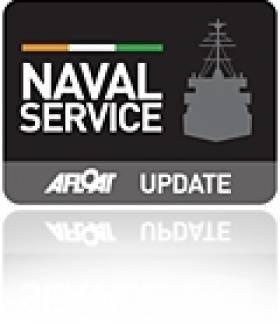Displaying items by tag: Six Service Fleet
#SixServiceFleet - The deployment of LÉ Eithne (P31) on a humanitarian mission to the Med, the fate of 'Aoife' and delays of newbuild OPV James Joyce, sees the Naval Service fleet reduced to 6 patrol vessels operating within Irish waters, writes Jehan Ashmore.
In recent years the Naval Service had a 8-strong fleet with the inclusion of LÉ Emer (P21) and sister LÉ Aoife (P22), however the former Offshore Patrol Vessel was sold overseas to Nigerian interests in 2013. This year the 'Emer' was transferred to the west African state's navy.
The 'flagship' LÉ Eithne commissioned as a Helicopter Patrol Vessel (HPV) made a transit of the Strait of Gibraltar this Tuesday heading for an Italian base port, yet the issue surrounding the decommissioned Aoife remains unresolved. This followed an Irish Government proposal to 'donate' the OPV to Malta but rebuffed by certain quarters of the island state's military as to her unsuitability in migrant SAR duties.
Afloat.ie has asked the Department of Defence for an update which responded with the same reply as previously reported (see report Aoife's almost full-circle role) in that the 'Department are in discussions with the Maltese authorities in relation to the modalities to be agreed in relation to the transfer of ownership of the decommissioned LÉ Aoife'.
As for the second newbuild Offshore Patrol Vessel (OPV) 90 class, James Joyce, she remains at the Babcock Marine & Technology Shipyard, Appledore in north Devon. As previously reported a month ago the newbuild had 'technical' issues following her first sea-trials that took place in March off Lundy Island in the Bristol Channel.
The Department however added that further trials of the James Joyce have since taken place.
It was also then reported last month that the €54m James Joyce would make her delivery voyage within weeks followed by a commissioning ceremony due this month. Whenever this ceremony takes place James Joyce will officially be designated with the ship's name prefix L.É. that means Long Éireannach or Irish Ship.
Currently the fleet that is in Irish waters comprises of a pair of 'Peacock' class coastal patrol vessels (CPV), three OPV's in the form of the sole remaining 'Emer' (modified Deirdre class) and a pair of 'Roisin' class OPV80s. The final unit is made of one Large Patrol Vessel (LPV) that been an enhanced version of the 'Roisin' class in the form of the 'Beckett' OPV90 class.
The Naval Service fleet of 7-strong patrol vessels are listed below.
HPV L.É. Eithne (P31) flagship (currently on overseas deployment)
CPV L.É. Orla (P41)
CPV L.É. Ciara (P42)
OPV L.É. Aisling (P23)
OPV L.É. Roisin (P51)
OPV L.É. Niamh (P52)
LPV L.É. Beckett (P61)
Each vessel is equipped with state of the art machinery, weapons, communication's and navigation systems.
In addition the Naval Service have on contract with Babcock Marine for a third and final sister of James Joyce which is due for delivery in 2016.
























































